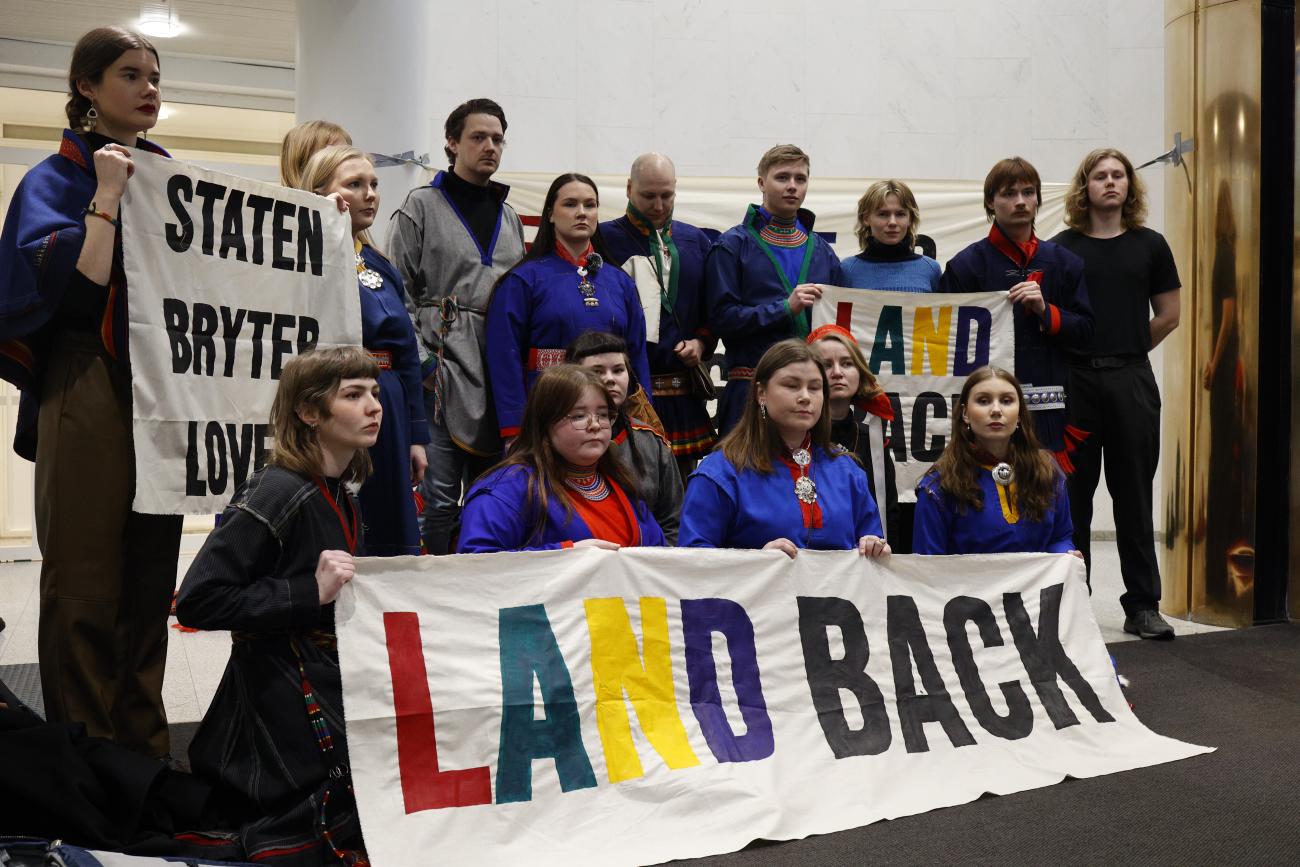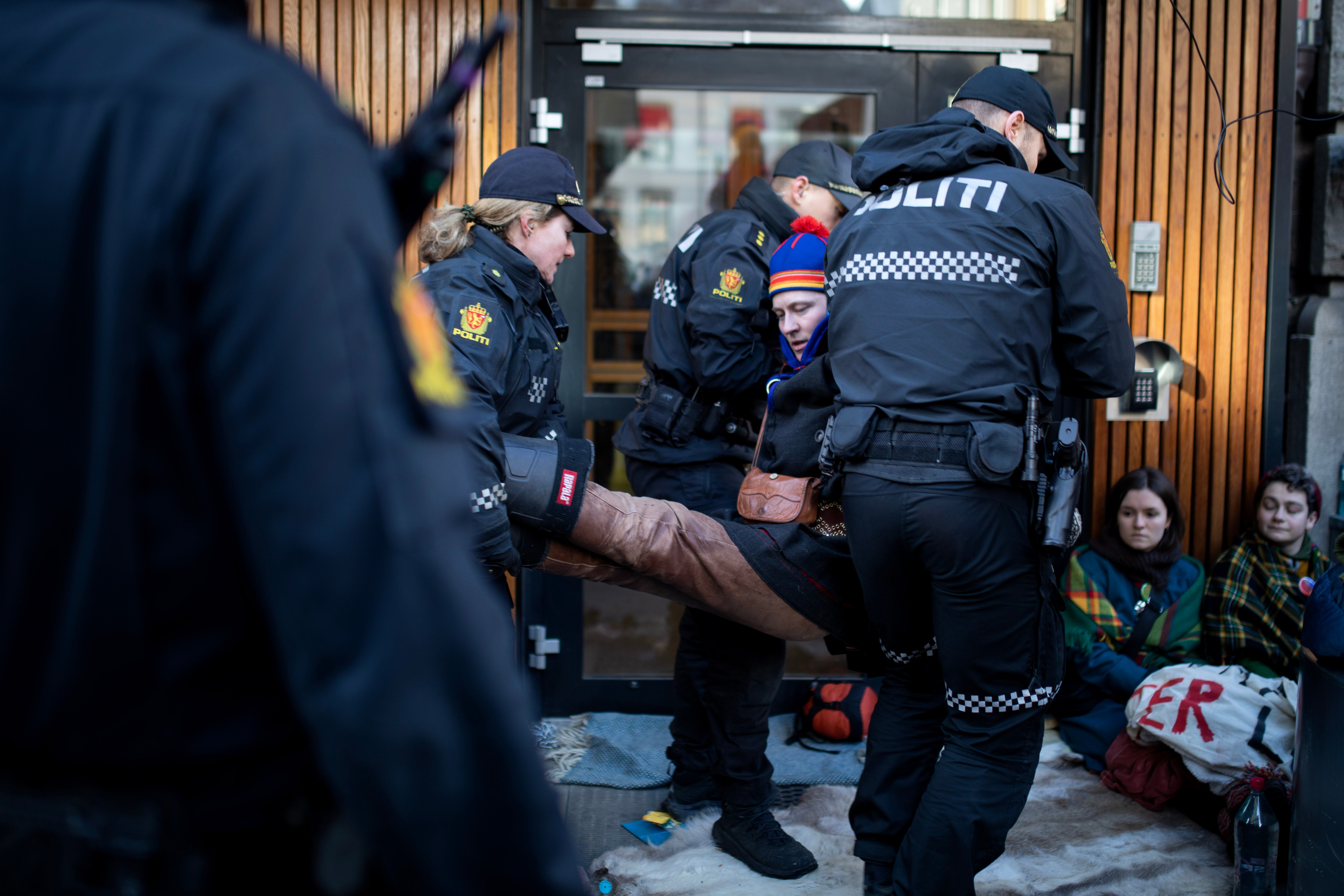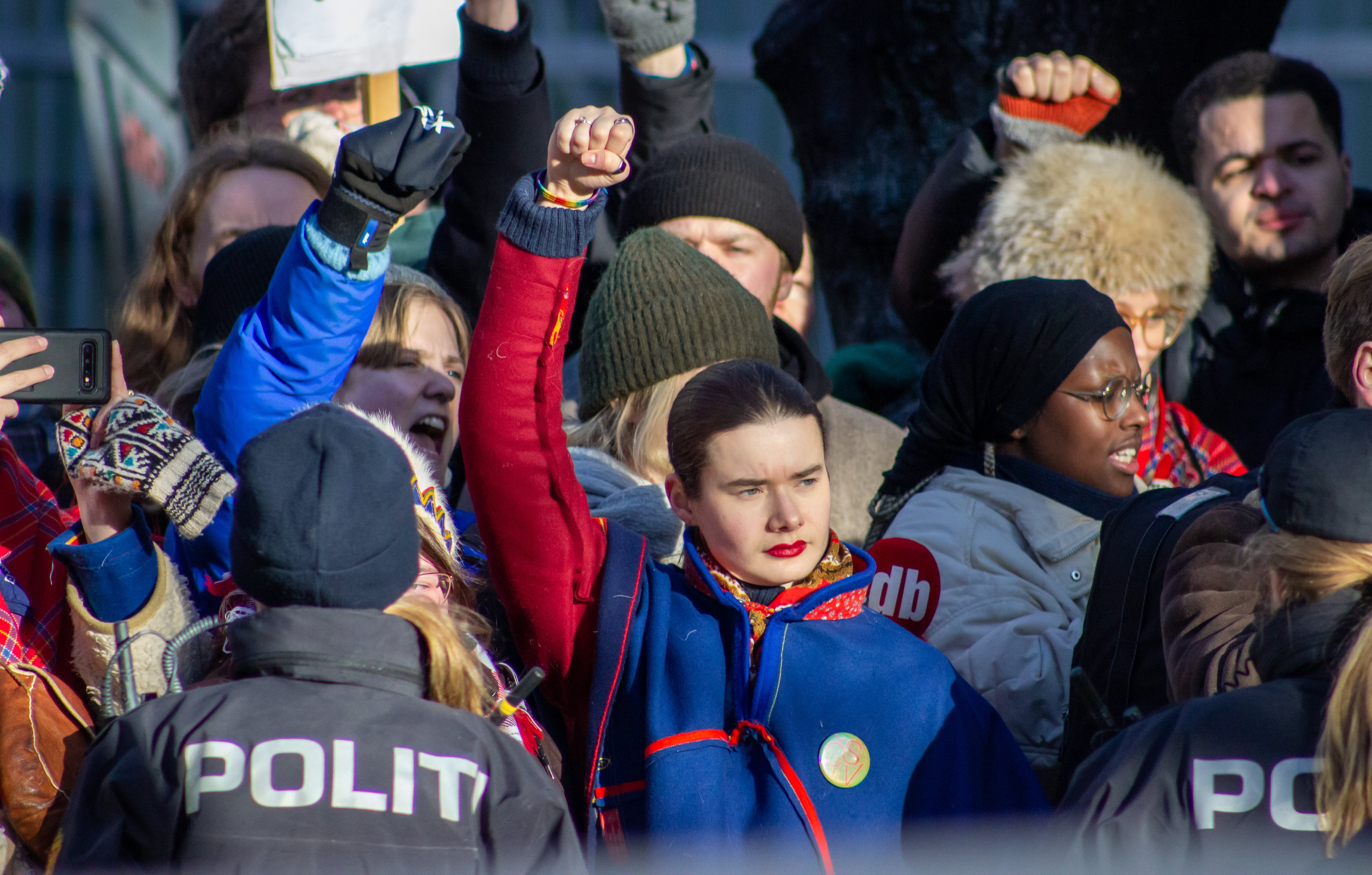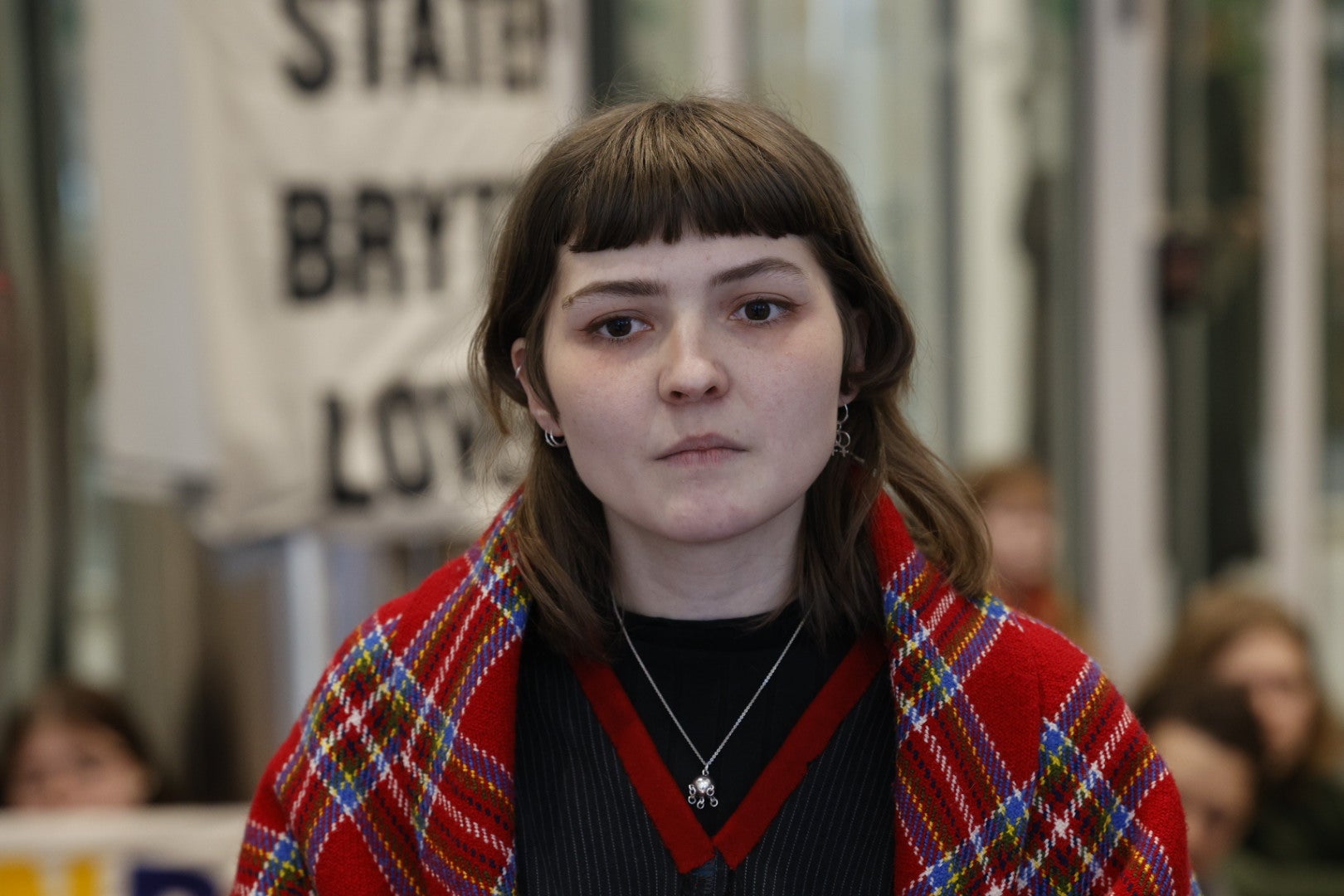
Thursday, February 23, 2023 marks the beginning of what has become the largest Sámi demonstration to date against the Norwegian Petroleum and Energy Department (OED), with demonstrators occupying a total of 10 government ministries during the 9-day-long action. This date also marks 500 days since the Norwegian Supreme Court unanimously ruled that two onshore windmill farms on the Fosen peninsula violate Sámi reindeer headers’ right to cultural practice (Article 27 of the International Covenant of Civil and Political Rights). Despite the court declaring the government’s concessions unlawful, the windmill farms remain fully operational and a threat to the livelihood of Sámi reindeer herders in the area. No solution is yet in sight.
After 500 days of Sámi human rights violations, a group of young Sámi activists refused to be silenced any longer, and in collaboration with Norwegian NGO Natur og Ungdom, they drafted the strategic plans for the rebellion. Kátjá Rávdná Broch Einebakken, a Sámi performance artist, expresses her gratitude for the partnership with young Norwegian climate activists, saying that their experience with civil disobedience made the fast-growing protest as safe and organized as possible, and ultimately a bigger success than previously anticipated.
They call it Operation: “Endgame,” a rebellion aimed at publicly demonstrating the discrimination by the government against the Sámi. “Like many other Indigenous groups, we experience the violence of silence. The Norwegian government are experts at pretending that they are anti-racist and ‘good’ to the Sámi people. For us, it has been hard to prove to the majority that the government is systematically discriminating against us. This time it was written [in black and white] that the government was breaking human rights. Still, it was hard to make the non-Sami population care. It all felt hopeless,” says Ida Helene Benonisen, a Sámi spoken word poet.
For four days Sámi activists occupied the OED lobby, and were denied access to food, toilet facilities, and medicine up until Friday night when a pro-bono lawyer secured access to these necessities. “The Ministry wanted to make us walk out of there by ourselves,” Benonisen explains. Kátjá Rávdná describes how OED employees were climbing over them, with some saying, “‘excuse me, I have to catch a train’, ‘you guys go!’ Some were grunting, annoyed. We were [inconveniencing them]. I remember feeling I was seeing a visual line between [Sámi and our issues]. For me, it was life or death, sitting in this lobby. For them, they had to get in their car before the parking fee increased. Yet again, they found themselves inconvenienced by Sámi—those people who never seem to be happy with anything.” Benonisen adds, “It was clear that they did not want pictures of young Sámi being brought out by the police. Instead, the employees of the [OED] worked from home so they did not have to see us.”
Sunday night, February 26, things changed drastically. Benonisen recalls how the police came in during the night while they were sleeping to carry them out of the OED lobby in an effort to avoid public attention to the Sámi demonstration. Fortunately, the activists had a photographer to document the course of the events. Outside, youth climate activist Greta Thunberg had arrived to show support for the rebellion. Benonisen remembers hearing Thunberg saying to the press outside the lobby, “It is clear now that the Fosen-saken cannot handle the light of day,” referring to the government-led silencing efforts in relation to the Fosen case and any action shedding light on the human rights violations directed at the Sámi population. Kátjá Rávdná describes how the Sámi activists responded to the police silencing and removal to maintain unity amongst the activists: “We yoiked [a traditional Sámi way of singing] every time someone was carried away by police to let them know that they and their actions are seen, they are not alone, and to give them strength.”
 Emil Ráste Nikolavu Kárlsen being carried away by police while blocking the Norwegian Ministry for Culture and Equality during the rebellion. Photo by Amanda Iversen Orlich.
Emil Ráste Nikolavu Kárlsen being carried away by police while blocking the Norwegian Ministry for Culture and Equality during the rebellion. Photo by Amanda Iversen Orlich.
By Wednesday, March 1, Day 506 of human rights violations, the small group of young Sámi activists had grown into an organized crowd of around 2,000. “The planes [arriving] from Sápmi were full. Seeing more and more Sámi people becoming a part of this gave me the strength I needed to keep fighting, even when I was exhausted. They kept me going,” Benonisen says. Kátjá Rávdná adds, “to me, the heart of the rebellion was love. Love for the people and lands we are fighting for. Love for each other, for the people present, and the people from all of Sápmi sending their warmth.”
Against the backdrop of this rebellion lies a history of shame, which puts the importance of protecting the right to cultural practice into perspective. Emil Ráste Nikolavu Kárlsen, a Sámi musician, explains that across borders, people in Sápmi have been oppressed by their respective governments for over 100 years. Being Sámi equated to feelings of shame, and, ultimately, his grandparents' generation didn't learn the Sámi language or pass down Sámi culture. Things began to change in the 1990s as that generation started to reclaim the Sámi identity and reframe Sámi culture as a heritage to be proud of. “This has been tough for many, and many are still in the process,” Kárlsen says, sharing that many in his family “still struggle with accepting that [they] are Sámi; some even deny it still.”
Benonisen tells a similar story: “I grew up in a family where the shame of being Sámi was strong. I often feel like I lost a lot of my culture and community.” Partaking in this rebellion felt like coming home to her. “It is so important to do everything in my power to shed light on what the government is doing because right now they are still forcing families to become more and more “Norwegian.” Everyday young Sámi are growing up just like me—ashamed. I refuse to stop fighting until this stops,” she says.
Reflecting on the Sámi youth presence during the demonstration in light of her own struggles with identity growing up, Benonisen says, “now it means everything. It took me many years to find my way back home, but today my Sámi family, friends, and community are as important to my being as my breathing. As a queer person, my Indigenous queer family has created a space for me that feels so incredibly safe. I feel very lucky.”
 Ida Helene Benonisen during the 9-day-long rebellion carrying a pin saying ČSV - initials commonly used to promote Sámi identity and activism. Photo by Jannicke Totland.
Ida Helene Benonisen during the 9-day-long rebellion carrying a pin saying ČSV - initials commonly used to promote Sámi identity and activism. Photo by Jannicke Totland.
On March 3, Operation: “Endgame” culminated with a symbolic blockade outside the royal castle created by around 2,000 people. Kátjá Rávdná recalls the meaningfulness of the rebellion's final demonstration, describing it as “a big ocean of color. We were not shouting, not chanting, but sitting in silence. The Sámi silence is different from the Norwegian. Our silence means you oppose. In the midst of the silent, colorful ocean, one could hear waves of yoik blowing through. A melody connecting us to each other, to our ancestors, to our land.” For Benonisen, too, this rebellion set an important precedent in the Sámi struggles against land expropriation: “We got to show the government that we refuse to be ignored and stolen from any longer.”
Kárlsen shares an important insight into the emotional strain of participating in such a high-stakes rebellion: “I felt some kind of ‘post-rebellion depression directly after,” he says. “I felt anger when I thought about those politicians who tried to mislead the discussions into irrelevant topics. I cried when I thought about how the government refused to change their mind, when they kept on seeing money as more important than people and nature.” For Kátjá Rávdná, the stakes were clear: “Growing up Sámi you grow up with the weight of your people's future on your shoulders. You may make or break the survival of your people. [The Sámi has] the law on their side, and the Norwegian people are agreeing with us. It has never been more clear who is ‘right’ here. This is a one-in-a-million chance, so you will take it. Protesting wasn't a choice. It was a necessity.” Kárlsen says his life changed after the rebellion. “I no longer feel as disconnected from how the decisions are being made in our society today, and I don’t accept unfair decisions as easily as I used to. I know it’s important to resist early in the process, and I am more awake now,” he says.
 Kátjá Rávdná Broch Einebakken clearly affected by the high stakes of the rebellion inside the OED lobby during the first days. Photo by Rasmus Berg.
Kátjá Rávdná Broch Einebakken clearly affected by the high stakes of the rebellion inside the OED lobby during the first days. Photo by Rasmus Berg.
The Fosen judgment underlines Sámi rights in Norway and provides a springboard for the Sámi to illustrate the faults of the so-called green energy transition; that is, it does not equal green energy at any cost. Benonisen believes that a green future cannot co-exist with violation of Indigenous rights. “We need Indigenous knowledge and traditions to bring the world into a greener future, and a green future without human rights is not a green future. What the government is practicing right now is green colonialism,” she says.
To Kárlsen, the “green transition is not green as long as it aims to keep capitalism alive and as long as it expropriates valuable intact land and land of Indigenous people.” Underscoring the importance of Sámpi to the Sámi identity, he adds, “It is crucial for a living culture. So the significance of the rebellion stretches far beyond the specific case [of the Fosen windmill farms].” To Kátjá Rávdná, the consequences of succumbing to the government’s unlawful concessions are clear: “If these turbines are allowed to stand, they will build more and more. Piece by piece, my homeland, my future, will all be gone. As my people are everything to me, if I lose them, I will lose myself. I am nothing without my people, so I will give my all to protect it.”
The Sámi demands to the Norwegian government are clear: tear down or halt the wind turbines, and find an alternative solution to the Fosen windmill farms that does not involve the Department of Petroleum and Energy.

